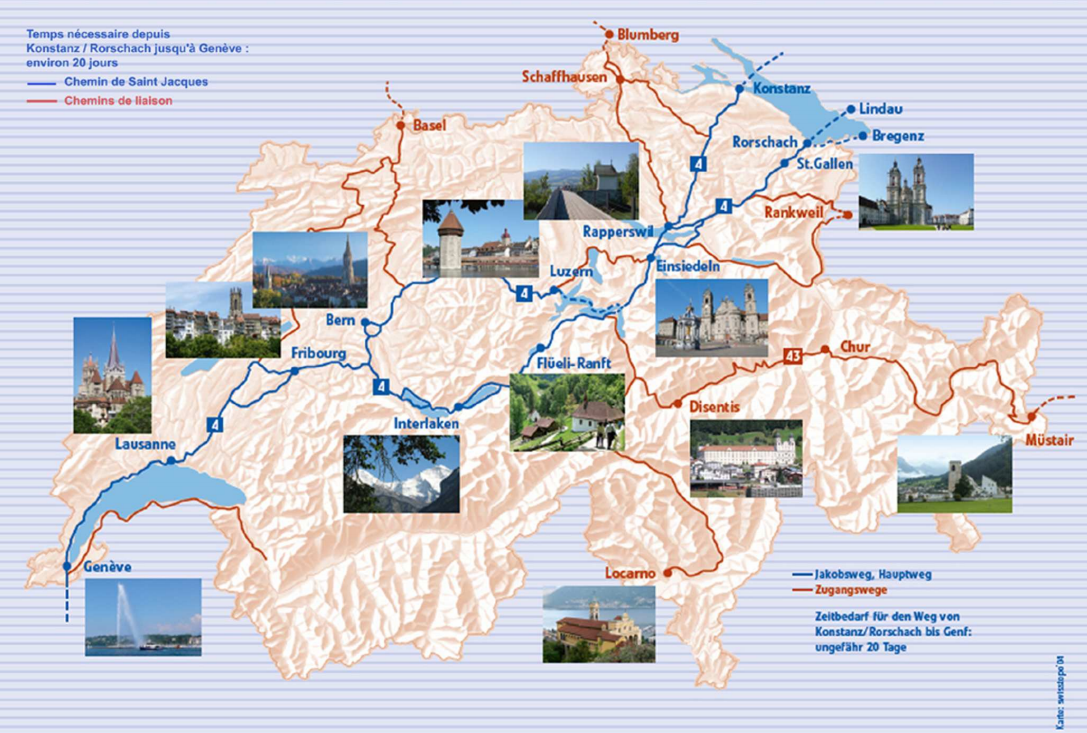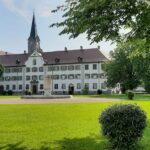Maximilian I (1469-1519), Emperor of the Holy Roman Empire, called the Rhine from Chur to Utrecht the ‘Pfaffengasse’. The Rhine offers this sight from Chur to Constance, Basel, Strasbourg, Worms, Speyer, Mainz, Bonn, Cologne, Xanten Nijmegen and Utrecht.
The region on the shores of Lake Constance (the Bodensee) can then be called the Monastery Road. This region had more than three hundred monasteries until the Reformation in the sixteenth century. It does show the rich religious, cultural and historical past of this part of the present-day countries of Austria, Switzerland and Germany.

(Source: www.jakobsweg-dachverband.ch)
Irish and English monks founded the first monasteries in the sixth and seventh centuries. Frankish rulers founded many monasteries In the eighth century, first the Merovingians and then the Carolingians. The reigns of Charlemagne (748-814) and his son Louis the Pious (778-840) are of particular relevance in this respect. The kings and emperors of the Holy Roman Empire and their appointed abbots and bishops continued this process from 962 until the Reformation.
Until the 11th century, the Benedictine Order was the only monastic community. With the rise of new monastic orders, the number of monasteries sharply increased. Franciscans, Dominicans, Cistercians, Augustinians, Capuchins, Carthusians, and others (for men and women) were founded.

A chapel near Höchst, Vorarlberg
The most important monasteries adapted their churches and living and working complexes to changing artistic styles and cultural insights. In contrast, others retained their original style to a greater or lesser extent. The region is, therefore, the setting for the Carolingian, Romanesque, Gothic, Renaissance, Baroque, and Rococo styles.
The Reformation (16th century), the Napoleonic era, and, in Switzerland, the decisions of cantons (19th century) also left their mark. Many monasteries were abolished and demolished; others were given other purposes. Some monasteries were used as medical centres; others were given a cultural or recreational function. The buildings were preserved in these cases, and the monastery church often retained its religious role. Monks or nuns still inhabit some monasteries.
Bregenz
A trip around Lake Constance can start in Bregenz (Vorarlberg, Austria). This town is known for its annual festival but also for the Wettingen-Mehrerau Monastery (1095), the Martinskirche (1361) and the Gallus Kapelle (1079) at the top of the hill. The promenade along the lake runs from the monastery to the city centre. A little further on is the monastery of Thalbach (1436), a spiritual centre today.






Wettingen-Mehrerau Abbey

The Oberstadt





St. Martin Church
Lindau
Lindau (Bavaria, Germany) is a peninsula. The Romans already inhabited it. They built the city walls and fort on the site of the Roman bathhouse. The Kanonissen monastery was founded in 822 and dissolved in 1803. The Franciscan monastery was founded in 1224 and disbanded in 1803. The Bavarian lion and the famous lighthouse keep a watchful eye after the nuns and monks had left the city.


The Kanonissen monastery

The Franciscan monastery


The Bavarian lion and the lighthouse

De Mang Tower
Salem
Salem Abbey (1136) was one of the wealthiest monasteries in the region until its dissolution in 1805. Anyone walking through the lavish French gardens and baroque complex has a different idea of monastic life. The Gothic cathedral and the baroque castle fit well into this picture of contrasts. The contrast with the monastery of Werd (canton of Thurgau) on the other side of the Untersee (the western part of Lake Constance) could not be more significant.

Salem Abbey. Photo: Carsten Steger
Birnau
The former monastery Birnau (1227) near Überlingen was best known as a pilgrimage to Mary until the nineteenth century. The rococo church from the eighteenth century is today’s main attraction after the monastery was dissolved in 1803. In 1919, the Wettingen-Mehrerau monastery acquired the church and in 1971, the Pope elevated it to Basilica Minor.

Priory Birnau. Photo: Kloster Mehrerau
Siessen
The monastery of Siessen (1260) survived the Reformation and destruction in the Thirty Years’ War (1618-1648). However, the monastery was dissolved in 1803, only to restart in 1860. With a hiatus from 1935-1945, the convent still functions with about 70 nuns.

Siessen Abbey. Foto: Kloster Siessen
Hegne
The nunnery of Hegne occupies a special place. Founded only in 1856, its community numbers as many as 2 800 nuns worldwide.
Constance
The Bishopric of Constance existed from 585 until its dissolution in 1821. The once mighty diocese even stretched as far as Kleinbasel until 1803! The Council of Constance (1414-1418) was its most famous moment; the burning of Jan Hus in 1415 was the anti-climax.
Constance switched to the Protestant faith in 1527. The bishop fled to Meerburg ( the bishop of Basel fled to Porrentruy (Pruntrut in German, today’s canton of Jura) that year.
There was no shortage of monasteries in this episcopal city; only all but one had been closed. The most important are the Capuchin Monastery, founded in 1603 and disbanded in 1816, the Dominican Monastery on the so-called Dominika Island (Dominikanerinsel), founded in 1236, dissolved in 1785; the Franciscan Monastery, founded in 1240, disbanded in 1808, and the Benedictine Monastery Petershausen, founded in 983, dissolved in 1802. However, the cathedral (Münster) still stands proudly without a bishop.



The Franciscan Monastery (a theatre nowadays)



The Dominican Monastery (a hotel nowadays)





The cathedral (Münster) of Constance


The Port of Constance, Imperia, statue (1993) commemorating the Council of Constance
Zoffingen
The convent has existed since 1257. It was initially a Beguine community, later a convent for nuns of the Augustinians and, from 1318, the Dominican nuns. The monastery still exists, albeit with a small number of nuns.
Kreuzlingen
Kreuzlingen Abbey (present-day canton of Thurgau, Switzerland) was a powerful princely abbey in the Holy Roman Empire. After being destroyed in the Thirty Years’ War, the monastery was rebuilt but closed in 1803.

Johann Sadeler, around 1633 (Staatsarchiv Thurgau, Frauenfeld).

Photo: Roland Zumbuel/Wikipedia.
Münsterlingen
The Benedictine Abbey of Münsterlingen was founded in 986. When Münsterlingen became Protestant in 1524, the abbey remained. The monastery church was even shared, Swiss-style, by Catholics and Protestants. Thurgau was an occupied territory (Untertanengebiet) of the Eidgenossenschaft from 1460-1798. Protestant and Catholic cantons or Orte governed this area. The monastery was closed in 1848.
Reichenau
The island of Reichenau is called a Klosterinsel or monastery island. Since 2000, it has even been a UNESCO World Heritage Site. The buildings of three monasteries are still standing: St Markus and Maria in Reichenau-Mittelzell, St Peter and Paul in Reichenau-Niederzell and St George in Reichenau-Oberzell.
Rorschach
A remarkable story concerns the Mariaberg monastery complex in Rorschach (canton of St Gallen). The monastery complex was completed in 1489 but then destroyed by citizens from Appenzell and the city of St Gallen before being consecrated and used as a monastery.
A generation before Martin Luther’s statements in 1517, the Church had already been exposed to much criticism. However, an army of the Swiss Confederation (St Gallen and Appenzell were not (yet) members) restored order in 1490, and the monastery was subsequently rebuilt, but not as a monastery but as the residence of the abbot of St Gallen.
The result was a Gothic complex partly destroyed by iconoclasm in 1529. Successive abbots of St Gallen rebuilt the complex in a late Baroque style in 1777.
When the St Gallen monastery was closed in 1803, the Mariaberg also lost its function. Since then, the canton has owned and used it as an education centre.





Conclusion
The region also has many chapels and churches. A bit further inland and upstream and downstream of the Rhine are many other monasteries, for example, in Disentis, Chur, Pfäfers, St. Gallen, Paradies, Stein am Rhein, Werd, Ittingen, Schaffhausen or Rheinau, to name but a few. The episcopal city of Basel had as many as ten monasteries in 1527.
These monasteries and their inhabitants preserved the heritage of antiquity; quite apart from the magnificent Romanesque and Gothic architecture, Gregorian chant, illuminated manuscripts, Baroque and Rococo palaces and other art, the Boden region is a monument for the monk.
(Source: D. Damwerth, Horizont Bodensee, Wenen, 2019; www.bodensee.eu)

Impressions of Bregenz

Lindau, view from Bregenz




The Bodensee near Bregenz and the Festspielplatz

Oberstadt and the medieval city wall
Impressions of Lindau

The former city hall (Rathaus)

Municipal museum (under renovation)



Villa and home of the exile of the Austrian Archduke and Duke of Tuscany Ferdinand IV (1835-1908)


The Parc of Lindau
Impressions of Constance

House of birth of Count (Graf) Ferdinand von Zeppelin (1838-1917)

Lindau, Zeppelin above the Casino, 4 June 2023


The bridge over the Rhine, the Bodensee becomes the Untersee


















































































